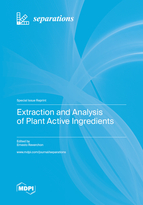Extraction and Analysis of Plant Active Ingredients
A special issue of Separations (ISSN 2297-8739). This special issue belongs to the section "Analysis of Natural Products and Pharmaceuticals".
Deadline for manuscript submissions: closed (30 April 2023) | Viewed by 35248
Special Issue Editor
Interests: supercritical fluids assisted processes; food engineering; chemical plant design; combustion; supercritical extraction; supercritical micronization; supercritical phase inversion; supercritical electrospinning; supercritical drying
Special Issues, Collections and Topics in MDPI journals
Special Issue Information
Dear Colleagues,
The extraction of active ingredients from vegetable matter is one of the most attractive research fields in the literature. A perspective that promotes this large interest is the possibility of identifying ecofriendly and innovative processes, active products and materials. However, care must be taken in selecting process arrangements and extraction conditions to minimize the coextraction of undesired compounds. The analysis of the composition of extracted compounds by chromatography, mass spectrometry and related techniques is a relevant step in determining the performance of the extraction process and the purity of the extracted compounds to be used for pharmaceutical applications.
Therefore, it is my pleasure to invite you to contribute your research article, communication, or review to this Special Issue dedicated to extraction processes, modelling and analytical techniques for the identification of active compounds extracted from vegetable matter.
Prof. Ernesto Reverchon
Guest Editor
Manuscript Submission Information
Manuscripts should be submitted online at www.mdpi.com by registering and logging in to this website. Once you are registered, click here to go to the submission form. Manuscripts can be submitted until the deadline. All submissions that pass pre-check are peer-reviewed. Accepted papers will be published continuously in the journal (as soon as accepted) and will be listed together on the special issue website. Research articles, review articles as well as short communications are invited. For planned papers, a title and short abstract (about 100 words) can be sent to the Editorial Office for announcement on this website.
Submitted manuscripts should not have been published previously, nor be under consideration for publication elsewhere (except conference proceedings papers). All manuscripts are thoroughly refereed through a single-blind peer-review process. A guide for authors and other relevant information for submission of manuscripts is available on the Instructions for Authors page. Separations is an international peer-reviewed open access monthly journal published by MDPI.
Please visit the Instructions for Authors page before submitting a manuscript. The Article Processing Charge (APC) for publication in this open access journal is 2600 CHF (Swiss Francs). Submitted papers should be well formatted and use good English. Authors may use MDPI's English editing service prior to publication or during author revisions.
Keywords
- Extraction
- Fractionation
- Active principles
- Vegetable matter
- Gas chromatography
- HPLC and related techniques
- Modelling
- Pharmaceutical application
- Nutraceutical application






